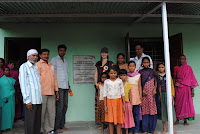Tigers and Lepers
So, I had a weird weekend, even considering that I was in a tiger village in the middle of India. Sunday morning I got woken up by a Hindu procession playing loud music outside my window at 6am and then I got racially profiled by some cops who tried to make me pay a “tourist” fee because they claimed I had lost my passport (which I hadn’t). I had a hotel room that lost power so frequently that I kind of gave up on having light or hot water. Just me and my industrial-strength bug spray. Which I had trouble finding in the dark, but whatever. At one point my host brought me to a leper colony. Not even kidding. I visited 2 events where I was asked to give speeches in front of hundreds of people, 10 events where I got flowers, and 3 homes where I was chastised for not eating enough and got to demonstrate my right-handed eating skills on the floor. I also took a picture with more or less every human I came into contact with.




In one town, I tried to use the bathroom in a villager’s house and was surprised to find that the concrete little room they brought me into had no hole in the ground – only one on the side wall. It turned out that this was only a “#1” toilet and to do “#2” you had to go to the next village over (or a nearby field). I determined all of this through charades as I don’t speak Marwari and the woman helping me didn’t speak English.
In one of the villages that I visited the women were wearing the best outfits – the massive gold nose rings were my favorite – and some of the most brightly colored, beautiful saris. As there were 20 of them in front of me, the color was almost overpowering. I was looking a little dull with my gray pants, gray shirt, and navy blue hat so they made me put a flower in my hat to liven me up a bit.

I was in the countryside to observe my NGOs field operations to get a better idea of how things run so that I can better design processes and business plans. After my time in the Peace Corps, I was not a big fan of NGOs because they tended to start unsustainable programs, provided handouts that created paternalism, and were just checking boxes on development tasks rather than promoting real impact. My current client has more or less renewed my faith in the work that they do. They have certainly moved, in many ways, towards creating programs that are more sustainable and the global push is definitely towards bringing in the private sector to make the things even more sustainable (which is what my work is).
There are still a number of handouts, but that is true of any government project – and in many aspects NGOs are just filling a vacuum left by government. They are building roads and schools, providing access to clean water, and educating children. Some of my Indian friends have argued that this allows the government to ignore the problems and get off scot-free, which is true. But the NGO is also lobbying the local governments and getting them involved in many projects, which certainly adds to the sustainability.
Additionally, I don’t know that it is so bad for NGOs to be filling the government vacuum (and do we really think if NGOs didn’t, the government would step in?) After all, NGOs are sort of like their own de-fact government with a global taxation system. Whereas normal government programs are funded by a redistribution of wealth (taxes) among people in the same country, NGOs are funded by a redistribution of wealth (donations) among people in different countries (we, as Americans, supply the vast majority). If that’s where the money is and governments don’t mind giving up some influence, perhaps it isn’t so bad…
For those of you interested in rural health programs in developing countries, I also had a chance to learn about a really interesting project where a U.S. software company created an application for cell phones that allows government health workers to track health data on mothers and children and provide them healthcare advice. It’s a really amazing application that helps government workers do everything from tell a woman when her due date is, to track a child’s weight, to provide detailed health care advice. I spoke to some healthcare workers about it and they loved it. The start-up costs for development of the app were funded by USAID and my NGO created the health training content. Now that start-up costs have been overcome and value proven, the Government of India is interested in scaling it to other parts of the country, and paying for it. These are the kind of programs that make you think that maybe this whole thing could work…
Meghan-
ReplyDeleteYou are my hero! Great blog....keep it up!
XOXO,
Anderjen